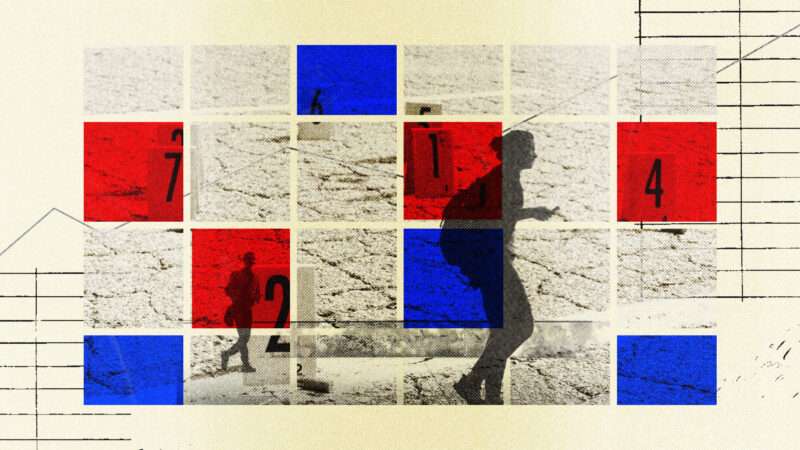
Polling data released this week shows that Americans’ views on nationwide crime rates have gotten closer to reflecting reality. But it’s less likely that we’re coming to our senses than that partisanship is skewing the data in a more accurate direction than usual.
“Americans’ perceptions of crime in the U.S. have improved,” writes Megan Brenan at Gallup, “with the percentage saying national crime has increased over the past year falling by 13 points, to 64%.” The number of respondents saying crime in the U.S. was “extremely” or “very serious” also dropped 7 points, to 56 percent, over the last year.
At first glance, this is good news, in that it increasingly reflects reality.
“Both the FBI and BJS [Bureau of Justice Statistics] data show dramatic declines in U.S. violent and property crime rates since the early 1990s, when crime spiked across much of the nation,” John Gramlich of Pew Research wrote in April 2024. “Using the FBI data, the violent crime rate fell 49% between 1993 and 2022” while property crime fell 59 percent over the same period. The BJS statistics were even more impressive, Gramlich found, writing that “the U.S. violent and property crime rates each fell 71% between 1993 and 2022.”
And yet people don’t seem to believe the good news. “In 23 of 27 Gallup surveys conducted since 1993, at least 60% of U.S. adults have said there is more crime nationally than there was the year before, despite the downward trend in crime rates during most of that period,” Gramlich added. Indeed, according to a graph on the latest Gallup release, the last year in which fewer than 60 percent of respondents—53 percent—said crime had risen over the previous year, was 2004.
While the newest Gallup survey continues that trend, in which a clear majority of people still think crime is on the rise, it also indicates that the numbers are moving in the right direction. But unfortunately, it’s unlikely that people’s perceptions are simply coming into line with reality.
As Gallup’s Brenan notes, partisanship seems to play the biggest role in the decline. “The October poll finds that partisans hold sharply differing views of the incidence of crime in the U.S., with Democrats’ much more positive perceptions driving the overall change since last year.” Indeed, while 68 percent of independents and a whopping 90 percent of Republicans said that crime was up over the previous year, only 29 percent of Democrats said the same. (Overall crime fell in 2023 and appears on trend to do the same in 2024.)
This would make sense, as a pure display of partisanship: Former President Donald Trump has underpinned each of his three runs for office by claiming that violent crime is out of control, so perhaps Republicans are more likely to believe him.
But the Gallup trend shows that since 1993, as violent crime rates have steadily fallen, Americans’ perceptions have shifted based on their partisan affiliation and the occupant of the White House: In 2004, during President George W. Bush’s first term, the 53 percent of respondents who thought crime had risen included 39 percent of Republicans but 67 percent of Democrats. (FBI statistics for that year indicated that both violent and property crime each declined by just over 2 percent in that year.)
On the other hand, Americans in general just seem particularly bad at judging crime trends: In 2014, 63 percent of all respondents told Gallup that crime was up over the previous year, including 57 percent of Democrats and 72 percent of Republicans. Meanwhile, 2014 turned out to be the least violent year in decades.
But Americans’ views on crime and criminal justice, no matter how capricious and ill-informed they may seem, are extremely consequential. After all, while the president likely has very little direct influence on criminal justice trends in your local police precinct, voters have the power to elect prosecutors, who wield tremendous power in deciding who faces prison time and how punitive their sentences could be. And there is evidence that voters’ perceptions of crime affect what kind of prosecutor they’re likely to favor.
“The growth in incarceration rates in the United States over the past 40 years is historically unprecedented and internationally unique,” a 2014 study found. “Local elected officials—including state legislators who enacted sentencing policies and, in many places, judges and prosecutors who decided individual cases—were highly attuned to their constituents’ concerns about crime. Under these conditions, punishment policy moved in a more punitive direction.”
Prosecutors recognize this, as well. In a 2022 draft policy paper, Harvard Ph.D candidate Chika Okafor found that “being in a [district attorney] election year increases total admissions per capita to state prisons and total months sentenced per capita,” meaning that prosecutors are more likely to seek prison time and longer sentences for offenders during election years.
And despite the fact that with some exceptions, crime has been on an overall downward trend for three decades, America still has the highest incarceration rate of any country.
Even though public opinion polls may or may not seem particularly compelling as examples of political trends, the way people feel about crime directly affects how they vote—and how the state treats those it arrests. As Okafor wrote, “collective approaches to transforming U.S. public opinion, and not simply technocratic approaches to policy, may be instrumental in curbing mass incarceration.”
The post Partisanship Determines What Americans Believe About Crime appeared first on Reason.com.






